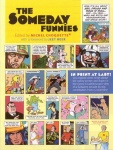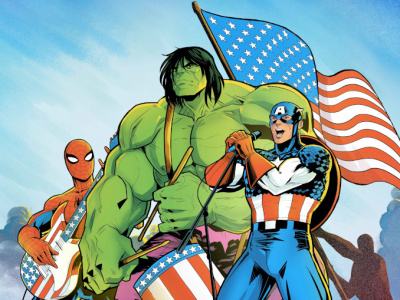 The Someday Funnies HC
The Someday Funnies HCPublisher: Abrams Comic Art
Release Date: November 2011
Price: $55.00
Creator(s): Various; Michel Choquette, Ed.
Format: 216 pgs., 16” x 12”, Hardcover
ISBN: 978-0-8109-9618-2
Age Rating: Unrated, but full of adult content
ICv2 Rating: 4.5 out of 5 stars
Finally in print after 40 years, The Someday Funnies began in 1970 when Rolling Stone commissioned a comic-format history of the 1960s that was to run as a special insert in the then hugely popular music/counterculture publication. Michel Choquette was in charge of the project and he stayed with it after it morphed briefly into a book deal that collapsed in the early 1970s after Choquette had commissioned and acquired contributions from a wide-range of creators from mainstream comics, the Underground Comix movement, and Europe (unfortunately, but understandably, Choquette ignored the burgeoning comic industry in Japan and Asia).
The Someday Funnies is then a veritable comic book time capsule, buried for 40 years and brought to life during an age which finally takes the medium as seriously as did the visionary Choquette, who was definitely on to something big with his project to capture the elusive essence of the 60s in comics. But in keeping with the artistic freedom that the decade had unleashed, Choquette left the choice of what aspects of the era to cover up to the artists, and the result, which reflects the fragmented nature of the decade that began with the ascendancy of TV's paean to fascistic federal police work in The Untouchables, (one of the top shows of 1960) and ended with turmoil in the streets when Nixon invaded Cambodia in 1970, is less of a mosaic than it is a "fly-eye" view that splits the decade up into hundreds of different, often unrelated facets.
The excellence of the contributions from artists with underground connections such as Justin Green, Jay Lynch, Kim Deitch, and Art Spiegelman certainly makes the reader wish that others like R. Crumb, Gilbert Shelton, Spain Rodriguez, Skip Williamson, Jack Jackson, and S. Clay Wilson (to name a few of the most prominent omissions) had been included. In general the mainstream artists tended to take the assignment more literally, though that doesn’t mean their contributions are any less interesting. Harvey Kurtzman's personifications of the decades of the 20th Century is typically trenchant, while Archie Goodwin deftly skewers the new trends that shook Hollywood in the 60s, and Herb Trimpe provides a powerful dose of "I was there" realism to his "grunts-eye-view" Vietnam War vignette.
Choquette also managed to get major artists from other disciplines to contribute with mixed results. The founding father of new journalism, Tom Wolfe, as might be expected, dissected the dangers of being a fashion pioneer to great effect in "The Man Who Always Peaked Too Soon," and National Lampoon scribe Chris Miller (with the able assistance of artist Gray Morrow) highlighted the defining tragedies of the decade by showing how they were avoided in the delicious alternate history parody "It's All a Clever Ruse Comix." As might be expected given the nature of his painting, the artist Red Grooms fits right in here, and science fiction writer Harlan Ellison's eco-parable is even more relevant today, but William S. Burroughs' piece trampling the ghost of Hemingway's bullfighting machismo reflects the author's 1950s beatnik concerns and appears curiously irrelevant in this volume.
Overall as a "cartoon history of the 1960s" The Someday Funnies with its scattered bi-continental focus would rate at best three stars, though future historians will find some key psychological insights here, especially in the profound effects that the decade’s assassinations (especially of JFK, who appears again and again throughout the book) had across the political and artistic spectrum. But as a portrait of the state of the medium of comics in the early 1970s in the U.S. and Europe, a yeasty blend of old and new that was poised to make a jump to the forefront of artistic endeavors in the 21st Century, The Someday Funnies is a five-star publication all the way.
--Tom Flinn: ICv2 VP-Content







